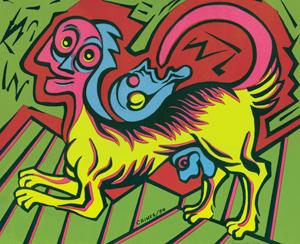Queen St West is a strange animal. Since moving to Toronto in 2002, I’ve always lived somewhere along it. I landed there accidentally, and I’m still baffled by the lightning speed of its transformation. When I arrived, the Drake and the Gladstone Hotels were derelict flophouses, and the street was dotted with a few galleries and legions of outpatients orbiting around the CAMH (Centre for Addiction and Mental Health) grounds. And now?
Queen West is a seeming microcosmic intersection of so many sociocultural issues that have shaped this city; an initially derelict neighbourhood populated by artists, whose transformation from the edge of civilization to the epicentre of a marketing team’s idea of urban cool was so quick, it shocked anyone with any stake in the street and its encompassing neighbourhoods. And that’s putting a strain on Queen West (or Queen West West, as it was once known — I’m talking specifically about the section of Queen West that’s west of, say, Dovercourt).
The artist population continues to be stunned by the implacable waves of development: first hotels, then bars, then condos, each casting a larger shadow across Queen West’s expanse. Condo developers have pounced on its marketability as an urban bohemian playground (and business associations have scrambled to keep up with them; witness the “walk on the wild side”–themed banners that adorn the street lamps). Queers (many of whom intersect with the artists) have tried to firmly stake out a territory that can function as an alternative to Village culture. Artists have tried to lay claim to the neighbourhood, whose bohemian aura they inadvertently helped perpetuate.
The current show at Toronto Free Gallery, Archiving the ’80s, offers an interesting history lesson on the beginnings of the Queen West art scene. If you have artist friends, you’re used to being handed invites to shows. They go in your pocket, then on your hall table, and then, once the show is over, they generally end up in the recycling bin. Curator Henrjeta Mece treats these objects as a kind of historical text, or if not the text, then certainly its illustrations. The walls are lined with posters: invites to art openings, screenings, happenings, performances, lectures.
These kinds of documents are, of course, the most ephemeral kind of documentation. They don’t really tell you anything about the content of these shows, only their locations and the artists involved. But Mece has arranged them like a puzzle. The recurrence of certain names and locations begins to divulge a story.
It’s fascinating to see where the Queen West scene began, and how instrumental queer artists were in creating it. First of all, its epicentre has migrated much further west since the ’80s. The Rivoli and the Cameron House (then the Cameron Public House) were ground zero; the vast majority of the events happened there.
The show also offers a glancing history of influential galleries: Carmen Lamanna (who worked with General Idea), Garnet Press, A Space, the Ydessa Gallery (before Ydessa Hendeles established her contemporary art fortress at King and Niagara streets).
And the list of queer artists who formed the foundation of this scene is legion: General Idea (they were still local boys, back then), Colin Campbell, Stephen Andrews, the shifting members of the Chromazone Collective (Andy Fabo, Oliver Girling, Evan Penny and others), Andrew James Paterson, Dennis Day, the Fastwürms.
The show offers glances and glimpses of a (heavily queer) culture that would eventually define a huge chunk of the city in the midst of its crucial formation. In many ways, it’s appropriate that we see it through the lens of its ephemera. After all, this culture was self-made, an outpost in a cold Protestant city that didn’t have much in the way of an established art scene.
The apocryphal nature of the publicity at Toronto Free Gallery pays honest homage to the improvisatory, provisional state of things. If there’s a criticism to be levelled at the show, it’s that it’s almost too ephemeral. There’s no didactic text throughout the show, and a viewer unfamiliar with the various names and locations along the walls might find themselves at sea. However, for those who have any kind of curiosity in piecing together the origins of Queen West, Mece and the Toronto Free Gallery offer a delightful puzzle.

 Why you can trust Xtra
Why you can trust Xtra


